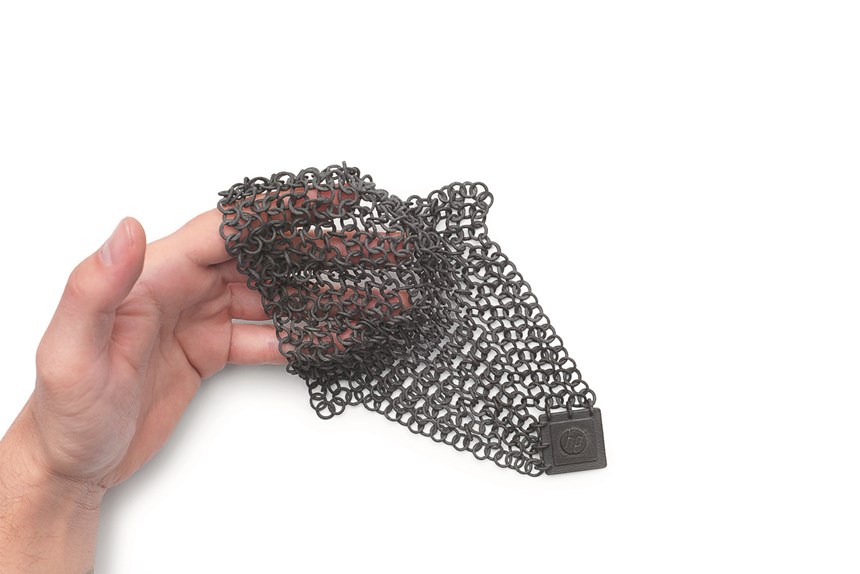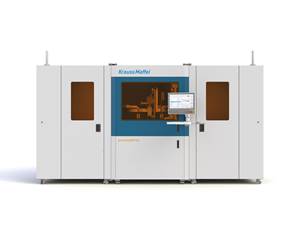New 3D Printers at NYC Show
Affordability, speed, and improved mechanical properties appeal to early adopters.
At least three new models of 3D printers were on display at the Design & Manufacturing Atlantic show in June at the Jacob J. Javits Convention Center in NYC. Some early adopters of new additive manufacturing (AM) technologies were also at the show.
SMALL, AFFORDABLE FDM PRINTER
A new FDM-type 3D printer from Cubibot, a San Diego-based startup, is described as one of the smallest printers on the market, “super-affordable,” and easy to use. It offers a 5-in. cubed print envelope within a 10-in. cubed footprint for the device. The refillable filament cartridge can run ABS, PLA, PC, and nylon materials. It’s expected to cost under $500 when it starts shipping in the next few months. (A kickstarter campaign is now underway.)
Despite its small size and price tag, the Cubibot is feature-loaded, according to Aria Noorazar, CEO/CTO. Not least is its precision, down to 0.1 mm. Unlike some other units, it also comes with a heated print bed as standard, and filtered ventilation for safer use. The printer is wi-fi enabled and operated with web-based software. Remote control is available via Android and iOS apps.
FDM printing now comes in a highly compact, “super-affordable” package.
LARGER CONTINUOUS PRINTER
A “game-changing” 3D printer that reportedly makes parts 25 to 100 times faster than any other additive manufacturing system is now available in a second, larger model. As
reported in our Nov. ’15 Close Up, the printer from Carbon3D, Inc., Redwood City, Calif., is unlike any other in that it does not print layer by layer, but continuously pulls a part upward from a pool of liquid photo-polymer that is solidified by UV light.
This reportedly yields isotropic properties more similar to those of injection molded parts. Also unlike other AM methods, which add layers to the top of the part, Carbon’s CLIP (Continuous Liquid Interface Production) technology (also known as DLS—Digital Light Synthesis) pulls the part upward from the liquid pool while curing at the bottom of the growing part. The pulling or “growing” speed varies automatically according to the cross-section of the part (faster where the part is thinner, slower where it is thicker). Compared with other AM systems, initial production time is said to be reduced from hours to minutes. However, the “green” parts require post-curing in a forced-air circulation oven to develop their full mechanical properties by a second chemical reaction.
Carbon introduced its first CLIP printer, the M1, in April 2016. It has a build volume of 5.6 × 3.1 × 12.8 in. (141 × 79 × 326 mm) and a pixel resolution of 75 μm. Now there is also the model M2 with twice the build volume but the same resolution. Also new is a Smart Part Washer as a separate unit.
Carbon3D has implemented a subscription pricing model, whereby an M2 printer costs $50,000/yr for a minimum term of 3 yrs. The M1 costs $40,000/yr. That includes current software and free updates, plus phone and email support and on-site service for repair and maintenance. Additional one-time expenses are a $5000 installation and training fee, and an “Accessory Pack” for $12,500 that includes the resin dispensing unit, UV lamp, and curing oven. The new Part Washer costs $10,000/yr (3-yr minimum) plus a $5000 installation fee.
Carbon3D has also expanded its range of liquid resins to include three grades of rigid urethanes, a flexible PUR, an elastomeric PUR, a cyanate ester with high heat resistance (HDT up to 219 C/426 F), an epoxy with properties resembling 20% glass-filled PBT (HDT of 140 C/284 F), a urethane methacrylate for making jigs and fixtures (properties similar to SLA resins), and a dental grade.
Also new this past spring is the first commercial application of CLIP technology, Futurecraft 4D running shoes from adidas. Using AM to make the lattice-design midsole allows personalization of each pair of shoes. More than 5000 pairs will be offered for retail this fall and winter, and more than 100,000 pairs are expected to be sold by the end of next year.
Novel continuous 3D printing process is now available with a larger build volume, achieves first commercial use.
Shortly after the adidas announcement, Carbon3D reported that Oracle Labs, the R&D arm of computer technology firm Oracle, commissioned printing of 10,000 server mounts (brackets for circuit boards) of Carbon’s rigid PUR. Injection molding was rejected as unable to provide the parts in a timely manner, while conventional 3D printing did not satisfy Oracle Labs’ performance requirements. One of Carbon’s first service-bureau partners, Sculpteo (locations in Paris and San Francisco), produced the brackets in days rather than months. Instead of printing the parts one at a time, Sculpteo produced a large cube of interconnected brackets.
Also at the NYC show was one of Carbon’s newest service bureaus, Dinsmore Inc., Irvine, Calif. Dinsmore recently added M1 and M2 CLIP printers to its roster of rapid-prototyping technologies—SLA, SLS, FDM, PolyJet, DMLS (direct metal laser sintering), plastic casting, and CNC milling. It also offers injection molding services though an outside partner.
Another new CLIP service bureau is Midwest Prototyping, Blue Mounds, Wis. This firm also offers SLA, SLS, FDM, PolyJet, binder jetting, PUR casting, and CNC machining.
LASER SINTERING UPGRADE
At the NYC show, EOS of North America, Inc., Novi, Mich., discussed its new EOS P 770 laser-sintering machine for thermoplastics like nylon 12, PEEK, and PEBA elastomer (a TPU is in the works). This high-capacity, dual-laser system is 20% more productive than its P 760 predecessor. Its large build volume (27.6 × 15 × 22.9 in. or 700 × 380 × 580 mm) allows production of parts up to 1 meter long.
QUICK-TURN SPECIALIST ADDS NEW PROCESS
Proto Labs, Inc., Maple Plain, Minn., a specialist in quick-turn prototyping and short-run manufacturing, announced at the show a new addition to its stable of prototyping technologies. Proto Labs announced it is now offering the Multi Jet Fusion process of HP Inc., Palo Alto, Calif., for production of fully functional plastic prototypes and production parts. Proto Labs already offers SLA, SLS, PolyJet, and direct metal laser sintering (DMLS), as well as CNC machining and injection molding. The firm served as a beta tester for the Multi Jet Fusion (MJF) process, which was first unveiled by HP in 2014 and became commercially available this May.
Questions About 3D Printing? Visit Our Additive Manufacturing Zone
The process builds up a part layer by layer. It involves inkjet spraying a digital pattern of droplets of fusing and “detailing” agents onto a bed of nylon 12 powder, followed by thermal fusion of the printed area. HP says MJF is up to 10 times faster than SLS and FDM processes. It deposits up to 30 million droplets per second per inch of working area, and it fuses the entire working layer at once, unlike most other processes. Proto Labs applications engineer Joe Cretella agrees that MJF is faster than other nylon-powder based 3D printing technologies and it also produces finer details, more isotropic properties, tighter tolerances, and smoother surfaces. As a result, MJF reportedly could compete with injection molding in some cases for volumes in the range of thousands of parts.
Related Content
Medical Manufacturer Innovates with Additive Manufacturing and Extrusion Technology Hubs
Spectrum Plastics Group offers customers two technology hubs — one for extrusion, the other for additive manufacturing — to help bring ground-breaking products to market faster.
Read MoreKraussMaffei Launches Two Additive Manufacturing Lines at K 2022
Long established in injection molding, extrusion and polyurethane reaction process machinery, 184-yr-old KraussMaffei prepares to enter the industrial additive manufacturing market.
Read MoreLarge-Format “Cold” 3D Printing With Polypropylene and Polyethylene
Israeli startup Largix has developed a production solution that can 3D print PP and PE without melting them. Its first test? Custom tanks for chemical storage.
Read MoreCustom Molder Manages Growth on Several Fronts
Adding people, plants and machines, expanding capabilities in LSR, high-tonnage presses, automation and 3D printing—EVCO Plastics maintains momentum through challenging times.
Read MoreRead Next
Troubleshooting Screw and Barrel Wear in Extrusion
Extruder screws and barrels will wear over time. If you are seeing a reduction in specific rate and higher discharge temperatures, wear is the likely culprit.
Read MoreWhy (and What) You Need to Dry
Other than polyolefins, almost every other polymer exhibits some level of polarity and therefore can absorb a certain amount of moisture from the atmosphere. Here’s a look at some of these materials, and what needs to be done to dry them.
Read More
































.png;maxWidth=970;quality=90)